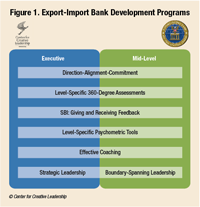The Public Manager Magazine Article
Creating a Shared Leadership Culture Through Multilevel Development
Do the leaders of your agency struggle to stay on the same sheet of music? Do some need developmental feedback, while others grow and change more quickly than the organization? Are members of your team lurching in a zombie-like fashion from one crisis to the next, with no real heart for the job or sense of commitment? If you answered yes to any of these questions, your agency most likely needs to build a more vibrant leadership culture. This is very important work for public managers at all levels. The U.S. Office of Personnel Management’s Executive Core Qualifications recognizes that developing others and giving them the opportunity to learn is a key component of leader development and organizational culture. Doing this across different levels, internal and external to your agency, reflects political savvy. Senior executives must do both to be effective within government. But how do you do it?
Sat Sep 15 2012




Do the leaders of your agency struggle to stay on the same sheet of music? Do some need developmental feedback, while others grow and change more quickly than the organization? Are members of your team lurching in a zombie-like fashion from one crisis to the next, with no real heart for the job or sense of commitment?
If you answered yes to any of these questions, your agency most likely needs to build a more vibrant leadership culture. This is very important work for public managers at all levels. The U.S. Office of Personnel Management's Executive Core Qualifications recognizes that developing others and giving them the opportunity to learn is a key component of leader development and organizational culture. Doing this across different levels, internal and external to your agency, reflects political savvy. Senior executives must do both to be effective within government.
But how do you do it?
Bridge Agency Culture Across Formal and Informal Relationships
Through our work at the Center for Creative Leadership (CCL), a not-for-profit focused exclusively on leadership education and research, we've consulted with a wide variety of public sector agencies that are struggling with culture issues. When we ask them what culture change means to them, similarities tend to emerge across agencies. We've seen that many government agencies share the same leadership challenges.
A common challenge is to establish a shared vocabulary or "language" for the agency. Also typically on the wish list are open communication and an environment that encourages those sometimes-difficult conversations that can be vital to the health of a department. Agencies want to become more open and accountable, with differences becoming less of a barrier. Within government, this matters a great deal because of the importance of transparency in dealing with lawmakers and taxpayers.
Unfortunately, many agencies proceed in an industrial manner. In attempting to establish a shared culture, they issue a policy letter or march their teams into lecture-based classes filled with endless PowerPoint presentations. These approaches have little or no effect on their audiences. At best, they communicate an implied threat: "My way or the highway!" Equally ineffective and doomed to failure is hoping for some sort of magical cultural osmosis.
Truly establishing a shared culture isn't something you can mandate. It takes time and leadership alignment and must cut across all vertical and horizontal levels of the organization. It must span divisions and organizational stovepipes. It must bridge both official reporting relationships and unofficial networks, across multiple levels of operation.
To achieve this shared state, you need a true "multilevel" approach to development—sharing the same (or largely similar) information across all the different strata within the organization. Teaching the same information in the same way at each level creates a shared, expected, and understood structure for communication. There is a common vocabulary and a common approach to leadership that creates a level playing field and affords all members of agencies an understood and shared starting point for leadership discussions.
One particularly effective multilevel development tool that can promote culture change is feedback. It's a shared pain point—people tend to be uncomfortable around the topic, whether they are giving feedback or receiving it. Establishing a common approach to feedback can provide a powerful tool for both individual and organizational transformation.
A Case Study: Export-Import Bank
The experiences of the Export-Import Bank of the United States offer a prime example. As the nation's official export credit agency, the organization enables U.S. companies to pursue export opportunities that promote job growth and contribute to a stronger economy.
The Export-Import Bank has worked hard in recent years to become more customer-focused—requiring managers and employees to collaborate more across organizational boundaries to coordinate the support they deliver.
To reach its strategic goals, the bank embarked on a comprehensive leadership development program for all leaders across its upper levels, including career executives and political appointees. These leaders focused on aligning their work behind shared goals, coaching more effectively, and improving feedback skills—with an aim to communicate and cascade change throughout the organization.
As CCL knows from years of experience, one lynchpin of effective coaching and mentoring is learning to give good, sound, developmental feedback—a leadership responsibility that is tough for virtually anyone to perform. It's easy to think of feedback as a confrontation and to avoid it like the plague.
Bank leaders learned to use CCL's highly effective, three-step Situation-Behavior-Impact (SBI) model that can remove a lot of the emotion from the feedback equation. They learned to:
focus on the specific situation
describe observations of the person's behavior in that situation
describe the impact that has behavior on the observer.
The model was taught in exactly the same way to all bank leaders,
regardless of level, experience, background, or other individual factors. Those learning the technique now share a common language and approach. They are able to deliver direct and objective feedback on a person's actions—not personal criticism, incorrect judgments, vague statements, or third-party slights. With clear, nonjudgmental, and specific feedback, the individual is more receptive and better able to determine which actions and behaviors to continue and which to change to improve performance.
Adopting this single, shared approach to feedback has had a ripple effect at the bank, as it has in other agencies that have adopted it. It is improving communication and accountability, promoting cohesion, and playing a vital role in promoting culture change.
While SBI is a particularly effective multilevel development tool for transforming organizational culture, there are other tools that also support this important work. For example, Export-Import Bank uses 360-degree assessment tools as part of its multilevel program. Each participant has a 360 experience, with the specific tool tailored to his or her level. Both levels delve into leadership concepts, focusing on either strategy or on spanning internal and external boundaries. But in each instance, leaders experience similar processes of assessment, increased self-awareness, and the development of new tools and approaches to become better leaders.
Case Study: The Intelligence Community
One of the largest organizations within the intelligence community (IC) also is committed to multilevel leadership development. The training and development of its leaders and employees is a key agency priority, and, like many members of the IC, it has its own internal college. The college's goal for the program described here was to modernize the organization's leadership and professional development program to achieve new levels of effectiveness in achieving their critical mission through improved communication and collaboration, operational and strategic skills, and creating and communicating an organization vision. In fact one of the organization's goals involves advancing visionary leadership and collaboration.
This organization wanted to customize an existing group of successful, interrelated leadership development programs to reflect its current mission, vision, culture, and core values. As part of a team led by BAE Systems, CCL developed and is delivering the six inter-related programs illustrated at left.
These programs serve dual goals. They must provide continuity across multiple levels of the organization, but also address the specific needs of each leadership level. For example, most of the programs include a psychometric instrument such as the Myers-Briggs Type Indicator or the Workplace Big 5 Profile 4.0. Each serves the same overarching purpose of promoting self-awareness, but varies in specifics to better meet the needs of each leadership level.
Executive coaching skills are taught in essentially the same fashion across multiple levels and programs, with examples and practice sessions based on the participants' particular responsibilities and challenges. As with the Export-Import Bank, the Situation-Behavior-Impact model of feedback is taught and practiced the same way at all levels—to develop an important skill, as well as a common language and culture, across the whole organization.
Results to Wake Zombies
What kinds of results can a multilevel approach to development produce? Given time, the "zombies" in government agencies can be brought to life—and perform at the high level expected of them by their leaders, peers, and the public.
You'll spot them talking in the hallways and playing an important role in sharing information up, down, and across the organization. You'll hear individuals use the same, readily understood terms to describe their interactions and personal development—all signs that your agency's culture is evolving in a positive direction.
